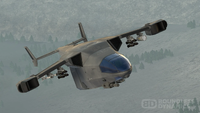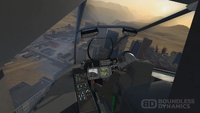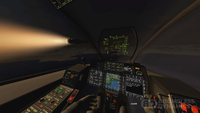AV-42C
- "Multi-role VTOL aircraft. Features tilting jet nozzles which give it the ability to take off, fly, and land vertically or horizontally. With a large cargo bay and multiple weapon mounts, this vehicle can perform both transport and attack missions."
- ― Aircraft Description
The AV-42C "Kestrel" is a Tilt-jet VTOL Attack/Transport aircraft. It was the first playable aircraft implemented in VTOL VR, and largely serves as the game's namesake.
Its tilt-jet VTOL flight setup gives it a surprising amount of mobility in the field. It is capable of taking off from and landing on both landing strips and helipads alike. Though it does not have as many weapon slots as the F/A-26B, and is more limited in the kinds of armaments it is capable of deploying, it makes up for this disparity with the already-formidable and versatile armaments it can equip. Coupled with its VTOL capabilities, the AV-42C can be a strong close air support asset when dealing with surface targets due to its high mobility.
Additionally, the AV-42C has full carrier deployment compatibility; it has both a launch bar for carrier takeoffs and an arrestor hook for carrier landings. It also includes a refueling port near the top of the aircraft to facilitate Aerial Refueling, thereby increasing its overall maximum flight range.
Strategy
The AV-42C's VTOL capability means that it flourishes in the field of air-to-ground combat. It is capable of equipping a myriad of missiles and bombs across its pylons, allowing it to fill a wide variety of ground-based combat roles. In horizontal flight, the AV-42C functions well as a strike aircraft; it can launch missiles at and drop bombs on targets at high speeds before going back around to make further passes. In vertical flight, however, it becomes a formidable asset in close air support tactics; its stabilized vertical flight allows it to make clean strafing runs against ground targets while maintaining a strong positional advantage against threats such as MANPADS units on the ground.
The biggest drawback of the AV-42C is that it remains somewhat vulnerable to hostile aircraft. As far as maneuverability goes, VTOL aircraft generally aren't very nimble in the skies, so one should be extra careful in the presence of enemies with radar-guided missiles available. Additionally, unlike other playable aircraft, the AV-42C has no onboard radar and can only equip heat-seeking missiles, making it a nonviable option for engaging hostile aircraft in an offensive posture.
Armament
Main article: AV-42C Hardpoints
Transport Capability
The AV-42C is uniquely able to load up and transport up to 8 allied Infantry or Infantry MANPADS units at a time. There is a switch on the right side of the AV-42C's cockpit for controlling the side doors for the passenger compartment.
Passenger transport is facilitated through objectives and triggers in the Mission Editor. To receive passengers, the AV-42C must be landed and have its doors open. From there, passengers will load into the AV-42C and can be transported to other destinations and let out the same way they would be let in. Each soldier loaded into the AV-42C adds 90kg of mass to the aircraft while loaded.
Cockpit & HUD Maps
Cockpit Maps |
|---|
AV-42C Cockpit - MainLoading scripts AV-42C Cockpit - Right-Hand ControlsLoading scripts AV-42C Cockpit - Left-Hand ControlsLoading scripts AV-42C Cockpit - Arm/Jettison ControlsLoading scripts AV-42C Cockpit - Heads-Up DisplayLoading scripts NOT PICTURED:
|
Gallery
A first-person perspective of an AGM-65 being launched.
| Playable Aircraft | |
|---|---|
| AV-42C • F/A-26B • F-45A • AH-94* • T-55* • EF-24G* | |
| *Downloadable Content | |
| Allied Military | |
|---|---|
| Aircraft | AH-94 • AV-42C • B-11 Bomber • E-4 Overlord • EF-24G • F-45A • F/A-26B • KC-49 Tanker • MQ-31 • T-55 |
| Ground Units | Boxer APC • Boxer IFV • C-RAM Truck • GECM Truck • Infantry (MANPADS) • Logistics Truck • Mobile Missile Warning Truck • M1 Tank • Rocket Artillery Truck • SLAM Truck • SRAD Truck • Watchman Truck |
| Stationary Emplacements | Bunker A • Bunker B • Backstop SAM (Launcher/Radar) • CIWS Turret • Decoy Launcher • Decoy Radar Transmitter • IRMD Launcher • SAM-P (Launcher/Radar) • SAM S/A Radar (Allied) |
| Sea | Aircraft Carrier • Allied Cruiser • Assault Carrier |
| Buildings | Early Warning Radar • Factory A • Storage Tent A • Missile Silo |
| (Parenthesis) denote unit variants. | |



